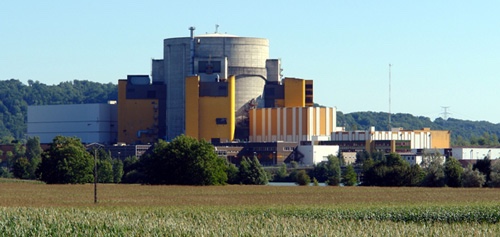Fast neutron reactors : the future of nuclear industry ?

PHENIX: a first fast neutron reactor
The PHENIX Marcoule reactor was a precursor. Fast neutron reactors allow getting more favorable neutron conditions for transmutation than industrial pressurized water reactors. PHENIX was used for this reason, to study the transmutation of actinides such as americium in the framework of research on radioactive waste.
© CEA
Reactors known as fast neutrons or breeders reactors do not need to slow down neutrons. With fuel enriched to 15 or 20% in uranium-235 or plutonium, it become no longer necessary to « thermalize « neutrons as in the common pressurized water reactors, for example. The major interest of fast neutrons is that they are able to extract all the fission energy contained in uranium of the earth’s crust.
Fast neutron reactors use mainly plutonium as nuclear fuel. Since they do not require any moderator, their core is 10 times more compact than those of conventional civilian reactors. Cooling is achieved with sodium or with molten lead. This cooling poses a safety problem, particularly concerning sodium, which reacts violently with air and water. But a breeder like PHENIX has been operating 40 years in France without accident, before its final shut down in 2011.
with sodium or with molten lead. This cooling poses a safety problem, particularly concerning sodium, which reacts violently with air and water. But a breeder like PHENIX has been operating 40 years in France without accident, before its final shut down in 2011.

The french breeder reactor SUPERPHENIX at Creys-Malville
SUPERPHENIX was a major breeder reactor designed to produce electricity. In 1996, frenh authorities decided to abandon the production of electricity, but to use the reactor fast neutrons to burn plutonium and radioactive waste. This option was abandoned in 1997.
© CEA – Common Wikipedia
Their main interest is to generate under certain conditions more fissile material than consumed. Such reactors are called « breeders ». Their principle is particularly attractive for power production, since breeders offer a virtually inexhaustible source of energy: one of the oldest fantasies of mankind , like a motor running with water ! It is estimated that one could extract with them 50 to 80 times more energy than with today ordinary reactors using slow neutrons to burn uranium-235.
Fast neutrons are also effective to burn the long-lived minor actinides of radioactive waste. With a breeder, the amount of plutonium remains in principle constant, because the fuel is regenerated. But regeneration is not mandatory. If regeneration is abandoned, it becomes also possible to burn plutonium partially or completely.
The first fast neutron reactor that supplied electricity at an industrial scale was the French breeder Superphenix. It was stopped in 1997 more for political than technical reasons. Various countries, including France, Japan and Russia are continuing research on this sector in the context of studies of fourth generation reactors. Russia operates in the Urals at Beloyarsk two fast reactors, BN-600 in operation since 1980 and BN-800 a powerful 883 megawatt unit commissioned in 2016.

Beloyarsk Nuclear Power Plant : BN-600
Main building of the Russian Beloyarsk nuclear power plant (seen here in 2005 through the Beloyarskoye lake-reservoir) near Sverdlovsk in the Russian Urals. The plant has a fast neutron reactor (BV-600) since 1980. A second more powerful unit((BN-800) of 883 megawatt is in operation since 2016 and is now the most powerful operating in the world. A third one is under consideration.
© Wikipedia commons
Fast neutron reactors could be started, when the time comes, using existing stocks of depleted uranium by-products of the isotopic separation process and of plutonium separated in the reprocessing of spent nuclear fuel. The amount of depleted uranium and of the uranium coming from the reprocessing, would be enough to make run for several thousands of years without using natural uranium. The plutonium of spent MOX fuel, currently in storage, could also be blended to 15% with depleted uranium.
As waste burners, fast neutron reactors may have to compete with hybrid reactors, whose principle was proposed by the Nobel Prize Carlo Rubbia in 1993. These hybrid reactors, might be dedicated to the destruction of actinides. They would have the ability to destroy plutonium and would additionally be safe.
NEXT : Why Fast neutrons ?